In this pillar piece, we have poured our expertise, tested strategies, and industry insights into one powerful resource. We will dive deep into the world of Search Engine Optimization (SEO) and provide you with the knowledge and tools to elevate your website’s visibility, attract organic traffic, and achieve online success.
We know you’re busy, so we’ve cut through the noise and distilled everything you need to know into actionable steps that deliver real results. No fluff, no jargon – just a straightforward “here’s what you need to do” approach.
In today’s digital landscape, having a robust online presence is crucial for businesses and organizations of all sizes.
With millions of websites competing for attention, it’s essential to implement effective SEO strategies that enable your website to stand out from the crowd.
Whether you’re a business executive looking to enhance your company’s online visibility or a business owner striving to drive more traffic to your website, this guide is your go-to resource.
Throughout this guide, we will demystify SEO Orange County and equip you with the foundational knowledge to understand its importance and impact. We will explore various aspects of SEO, from the basics to advanced techniques, ensuring that you understand how to optimize your website for search engines.
Here’s a glimpse of what you can expect to find in this pillar post:
- Understanding the basics of SEO
- How to set SEO goals and identify your audience
- How to do keyword research
- On-page and off-page SEO practices
- Technical SEO, and
- How to stay up to date with the trends
These are the same things we did both for our website and that of our clients. By the end of this comprehensive guide, you’ll have the knowledge, tools, and confidence to optimize your website for search engines effectively.
Whether you’re a beginner or have some experience with SEO, this guide will serve as a valuable resource to help you achieve SEO success and drive organic traffic to your website.
So, let’s embark on this exciting journey together and unlock the secrets of SEO that will propel your website to new heights of visibility and success.
- Understanding the Basics of SEO
- Defining Goals and Target Audience
- Keyword Research: Unleashing the Power of Words
- On-Page Optimization: Boosting Your Website’s Performance
- Technical SEO: Building a Strong Foundation
- Off-Page Optimization and Link Building
- Monitoring and Analyzing SEO Performance: Unlocking Insights for Success
- Staying Ahead of the Curve: Keeping Up with SEO Trends and Algorithm Updates
- Empower Your Online Success with SEO
Understanding the Basics of SEO
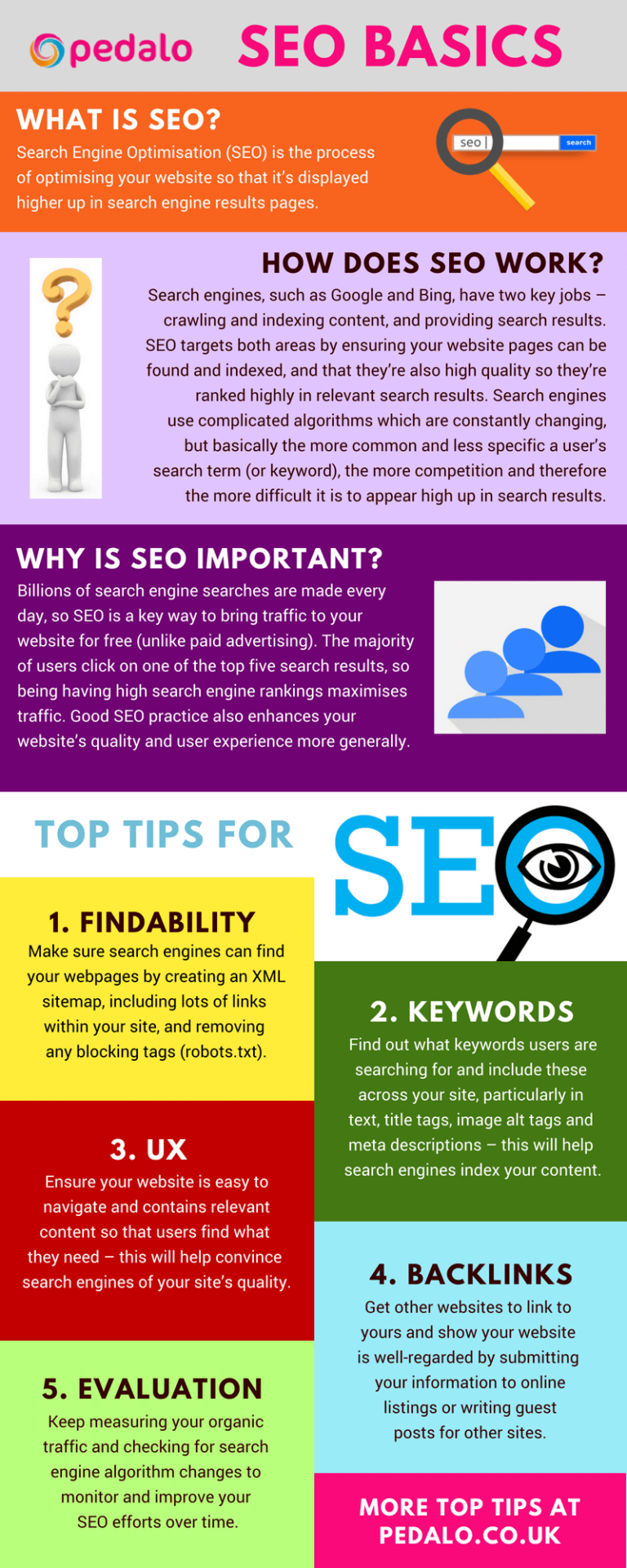
SEO, or Search Engine Optimization, is a set of strategies and techniques aimed at improving a website’s visibility and ranking in search engine results pages (SERPs).
In simpler terms, it’s the process of making your website more attractive and accessible to search engines like Google, Bing, and Yahoo, so that they can understand and recommend it to users who are searching for relevant information, products, or services.
When you search for something on a search engine, you’re presented with a list of results that are considered the most relevant to your query.
The order in which these results are displayed is determined by complex algorithms used by search engines.
SEO helps you optimize your website to meet the criteria of these algorithms, increasing your chances of ranking higher and driving more organic (non-paid) traffic to your site.
The goal of SEO is not just to get more traffic to your website, but to attract the right kind of traffic—people who are genuinely interested in what you have to offer.
When your site appears higher in search results, more people will click on it, visit it, and maybe even buy your products or services. It’s like getting more foot traffic to your virtual store.
By understanding the intent and behavior of your target audience, you can optimize your website’s content, structure, and technical aspects to provide a great user experience and make it easier for search engines to understand and recommend your site.
How do Search Engines Work?
Search engines are like the helpful librarians of the internet. When you search for something, they go through their massive collection of web pages to find the most relevant ones. As we mentioned before, they do these using algorithms, which are like sets of instructions that help them organize and rank web pages. They do this by crawling, indexing, ranking, and displaying results on the results page.
Crawling
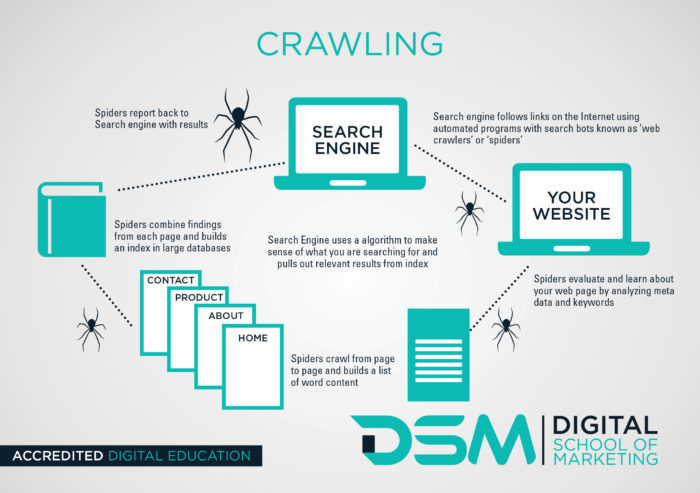
Source: DigitalSchoolofMarketing
Before search engines can show your website in search results, they must “crawl” it. It’s like a robot spider that follows links from one web page to another, gathering information about each page.
Once a search engine finds your site, it reads all the text, looks at the images, and takes note of other details.
Indexing
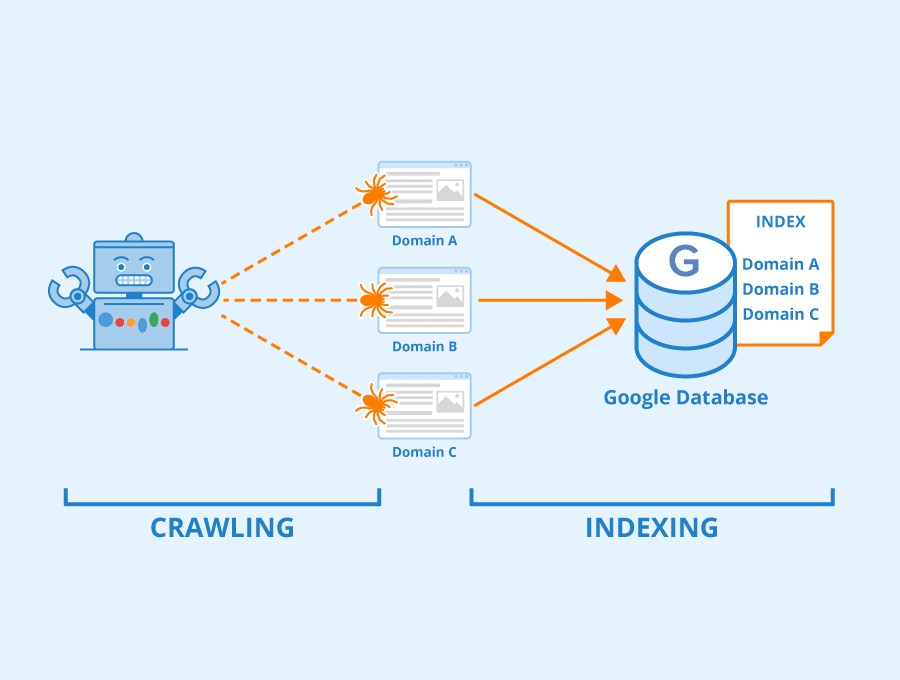
After a crawler visits a web page, it analyzes the page’s content and stores the relevant information in a massive database called an index. The index is like a vast library catalog that keeps track of all the web pages the search engine has crawled.
Ranking
When a user enters a search query, the search engine’s algorithm springs into action. It sifts through the index to find the most relevant web pages that match the query.
The algorithm takes into account various factors like keyword usage, relevance, user experience, and website authority to determine the ranking of the web pages.
Displaying Results
After ranking, the search engine then displays the search results on a search engine results page (SERP). The SERP typically includes a combination of organic (non-paid) results and paid advertisements.
Search engines have secret formulas to determine which web pages should be shown first in search results. They consider many things, called ranking factors, to decide how relevant and trustworthy your website is.
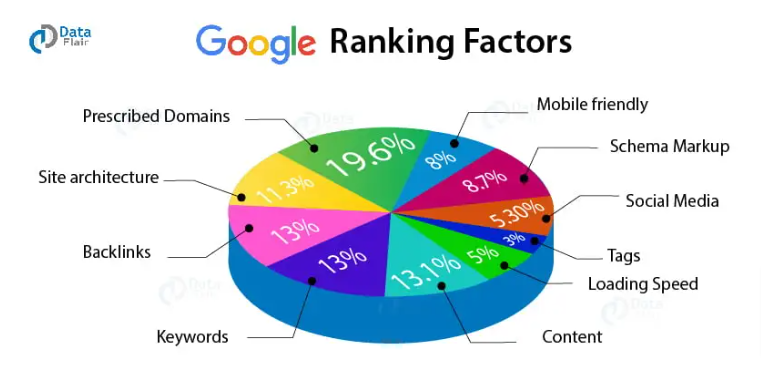
Factors like the quality of your content, the number of other websites linking to yours, and how well your site is structured can all influence your ranking.
The structure of your website also plays a significant role in search engine rankings. Search engines favor websites with clear, organized structures that make it easy for both users and crawlers to navigate.
Implementing proper header tags, descriptive URLs, and logical site architecture can enhance your website’s visibility and accessibility to search engines.
Understanding how search engines work and the factors they consider is the first step in optimizing your website for better visibility. However, it’s equally important to define your goals and target audience.
By having a clear understanding of your business objectives and the specific audience you want to attract, you can tailor your SEO strategies to align with those goals.
Defining Goals and Target Audience
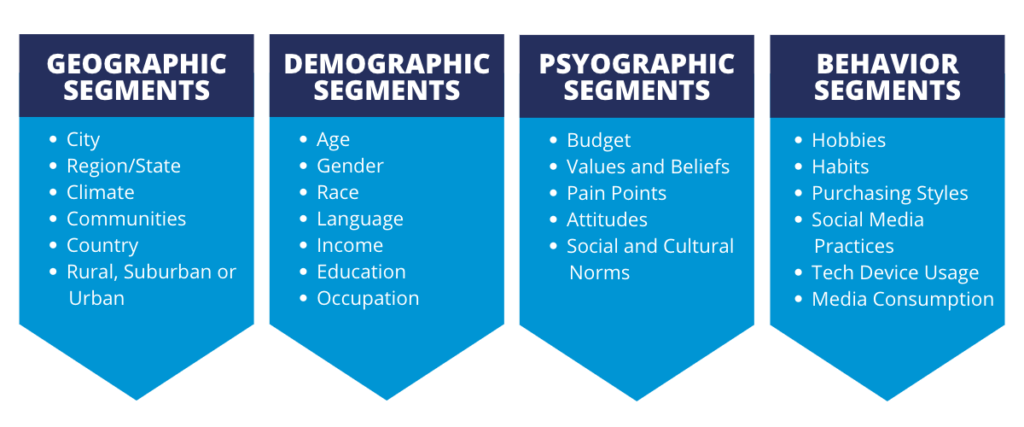
Source: WayPointMarketingCommunication
Setting clear goals and understanding your target audience are fundamental steps to creating an effective and successful SEO Orange County strategy.
What are Your Business Objectives?
Are you looking to increase website traffic, generate more leads, or boost your sales? Defining your goals helps you stay focused and measure the success of your SEO efforts.
For example, to increase website traffic, you can set a goal to attract a certain number of monthly visitors. If generating leads is your priority, you can aim to get a specific number of inquiries or sign-ups.
And if boosting sales is what you’re after, you can track the revenue generated from organic search traffic. Setting clear goals will guide your SEO strategy and give you something to aim for. You also need to know exactly who you want to reach.
Who is Your Target Audience?
It’s essential to understand who your ideal customers are so that you can tailor your SEO efforts to attract them. Think about their demographics, interests, and even their search behaviors.
Ask yourself: Who would benefit most from your products or services? What age group are they in? Are they predominantly male or female? What are their interests, hobbies, or professions? Understanding these details helps you create content and optimize your website in a way that resonates with your target audience.
Knowing their search behaviors is also crucial. How do they search for information online? What keywords or phrases might they use? By understanding their search habits, you can incorporate those keywords into your website content and improve your chances of showing up in their search results.
The easiest and most effective way to know your target audience is to create a buyer persona for your business.
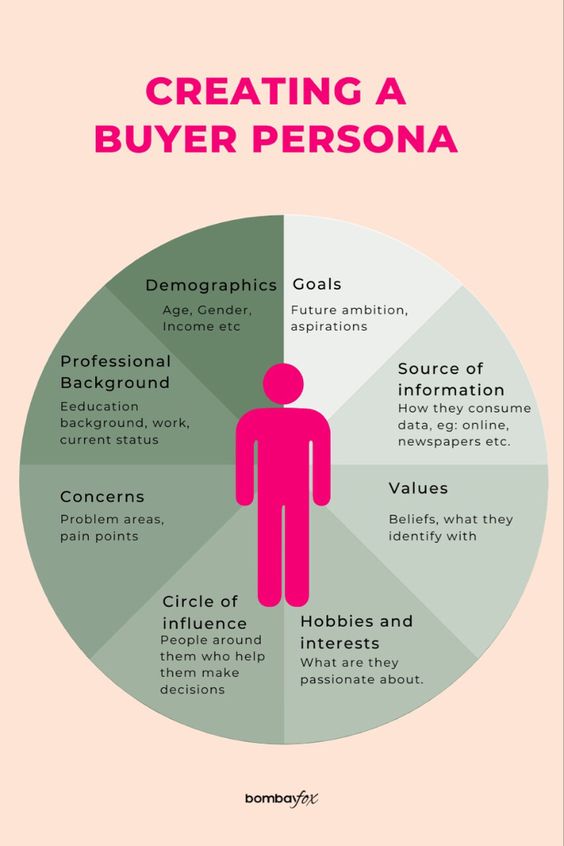
Creating a buyer persona involves giving them a name, understanding their demographic details, interests, and behavioral traits. It’s about diving deep into their goals, pain points, and buying patterns.
You can even go the extra mile by visualizing them using stock photography or illustrations, which can help your team put a face to the name.
The idea is to treat this model customer as a real person, to think and speak about them as if they were right in front of you. This level of personalization enables you to craft marketing messages that resonate specifically with them.
When you have a clear image of who your ideal customer is, you can tailor your marketing efforts to connect with them on a deeper level, speaking their language and addressing their unique concerns.
Defining your goals and identifying your target audience lets you focus on attracting the right people and converting them into loyal customers, thereby aligning your SEO strategy with what truly matters for your business.
So take some time to reflect on your goals and get to know your target audience. The better you understand them, the more effective your SEO efforts will be.
Ready to connect with your ideal customers? Let’s dive in and create an SEO strategy that hits the bullseye. We begin with keyword research.
Keyword Research: Unleashing the Power of Words
Keywords play a pivotal role in the world of SEO. They are the words and phrases that people type into search engines when they’re looking for something. Understanding how to conduct adequate keyword research is like having a secret weapon to boost your website’s visibility and attract the right audience. Let’s dive in and uncover the secrets of keyword research.
How to Conduct Keyword Research
To embark on your keyword research journey, you’ll need some trusty tools by your side. Google Keyword Planner, SEMrush, and Moz are some popular ones that can guide you in uncovering valuable keywords.
These tools provide insights into the search volume and competition, helping you find the perfect balance.
Start by brainstorming some general keywords that people might use to find businesses like yours.
For example, if you have a bakery, you might think of keywords like “freshly baked goods” or “cakes’ or “artisanal pastries.” Then, use the keyword research tools to explore related keywords and discover their search volumes and competition levels.
Look for keywords with a decent search volume—enough people searching for them—but keep an eye out for those with low competition. These gems can give you an advantage in ranking higher in search results. Also, consider long-tail keywords, which are longer, more specific phrases. They may have lower search volumes but can bring in more targeted traffic.
Remember, keyword research is not just about finding the most popular keywords. It’s about finding keywords that align with your business and target audience. That begs in the question…
Which Keywords are Relevant to Your Business?
Finding relevant keywords requires a deep understanding of your business, products, services, and, most importantly, your target audience. It’s like getting into the minds of your potential customers and figuring out what words they’d use to find you.
Put yourself in their shoes and consider their needs, desires, and pain points. Think about the problems you’re solving or the solutions you’re providing.
If you offer eco-friendly cleaning products, relevant keywords might include “natural household cleaners” or “eco-friendly cleaning supplies.”
Additionally, you can analyze your competitors’ websites to gain inspiration. Look at the keywords they are targeting and see if there are any gaps or opportunities you can capitalize on. By understanding your competition, you can refine your keyword list and stand out.
Remember, keyword research is an ongoing process. As your business evolves and trends change, keep revisiting your keyword strategy and adapt accordingly.
Stay up-to-date with industry trends, search behavior shifts, and emerging keywords to remain relevant and visible.
So, armed with your keyword research tools and a deep understanding of your business and audience, you can unleash the power of words.
Incorporate these carefully selected keywords into your website content, meta tags, and blog posts. By doing so, you’ll increase your chances of appearing in search results when your potential customers are actively searching for what you offer.
The following sections will explain exactly how to incorporate these keywords into your website.
On-Page Optimization: Boosting Your Website’s Performance
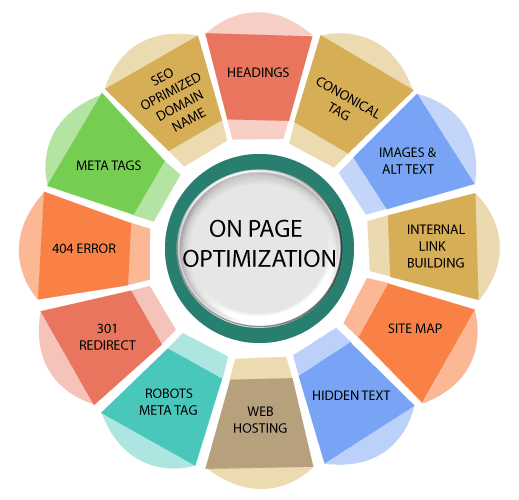
On-page optimization refers to the crucial practice of optimizing various elements on your website to improve its visibility and ranking in search engine results. It involves making strategic changes to the content, structure, and HTML source code of individual web pages to make them more search engine-friendly.
Regarding SEO, on-page optimization is crucial in making your website more user-friendly. By optimizing various elements of your web pages, you can enhance their visibility, user experience, and overall performance. Let’s dig deeper into the world of on-page optimization and uncover some key strategies!
How to Optimize Your Website’s Content?
Optimizing your website’s content involves fine-tuning various elements to make them more appealing to both search engines and users. Let’s explore a few essential aspects:
Meta tags (title and description): These tags provide brief summaries of your web pages in search engine results. Craft engaging and keyword-rich titles and descriptions that accurately represent the content on each page. This will entice users to click through to your website.
Headers (H1, H2, etc.): Headers help organize and structure your content. Use descriptive and keyword-rich headings to guide both users and search engines through your page. They not only improve readability but also signal the relevance of your content.
URL structure: Ensure your website’s URLs are clean, concise, and relevant to the content on each page. Include targeted keywords when appropriate. A clear and user-friendly URL structure makes it easier for search engines to understand your page’s topic.
Content optimization: Create high-quality, informative, and engaging content that addresses the needs and interests of your target audience. Incorporate relevant keywords naturally throughout the content, but avoid overstuffing.
Remember, content should be written primarily for users, not just for search engines.
Mobile-Friendly Website
With the increasing use of smartphones and tablets, having a mobile-friendly website is crucial for SEO success. A mobile-friendly site adjusts its layout and content to fit different screen sizes, providing an optimal user experience. Here’s why it matters:
User experience (UX): A mobile-friendly website ensures that visitors on mobile devices can easily navigate, read, and interact with your content. It reduces the need for zooming or horizontal scrolling, enhancing the overall user experience.
Search engine rankings: Search engines prioritize mobile-friendly websites in their rankings, especially for searches performed on mobile devices. A responsive website that caters to mobile users can give you an edge in the search results.
To make your website mobile-friendly, consider using a responsive web design, which automatically adjusts the layout based on the user’s screen size. You can test your site on different mobile devices and use Google’s Mobile-Friendly Test tool to identify and fix any issues. Another on-page optimization technique we used is page load speed.
Are Your Pages Loading Quickly?
Page speed is a critical factor influencing user experience and search engine rankings. Nobody likes waiting for a slow-loading website, right? Here’s how you can speed things up:
Optimize images: Compress and optimize your images without sacrificing quality. Use appropriate file formats (such as JPEG or PNG), resize images to the required dimensions, and leverage image compression tools.
Minimize code: Reduce unnecessary code, such as whitespace, comments, and unused scripts. Optimize your HTML, CSS, and JavaScript files to improve load times.
Caching techniques: Implement browser caching, which allows users’ browsers to store specific website resources locally. This way, subsequent visits to your site will be faster since the browser doesn’t need to retrieve all resources again.
These days, it’s rather easier to monitor your website’s load speed and detect any anomalies. Tools like Google PageSpeed Insights or GTmetrix provide insights and suggestions for improving speed.
By optimizing your website’s content, ensuring mobile-friendliness, and enhancing page speed, you’ll create a better experience for your users and improve your search engine rankings.
Regularly review and update your on-page optimization efforts as you change your website or create new content. SEO is an ongoing process, and staying proactive will help you maintain a competitive edge.
Keep in mind that on-page optimization is just one piece of the SEO puzzle.
It works hand in hand with other SEO strategies, such as off-page optimization (building backlinks, social media presence) and technical optimization (site structure, sitemaps).
Combining these approaches, you can create a well-rounded SEO strategy that maximizes your website’s visibility and attracts the right audience.
Technical SEO: Building a Strong Foundation
Technical SEO is like the backbone of your website. It ensures that search engine bots can crawl, index, and understand your website effectively.
By addressing technical issues, optimizing URL structure, and implementing structured data, you can enhance your website’s visibility and overall performance.
Let’s delve into the world of technical SEO and explore some key considerations.
Website Crawlability
Search engine bots need to crawl and index your website to include it in their search results. To ensure your website is crawlable, you need to address various technical issues. Let’s take a closer look at a few common ones:
Broken links

Broken links, also known as dead links, lead to pages that no longer exist or return error codes. These can hinder search engines from effectively crawling your website. Regularly check for broken links and fix them promptly.
Duplicate content
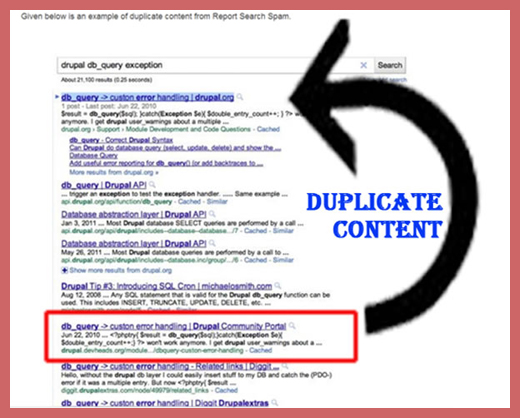
Having duplicate content can confuse search engines and negatively impact your website’s rankings. That is why you must identify and resolve any instances of duplicate content by using canonical tags or implementing 301 redirects.
XML sitemap errors
An XML sitemap is a file that provides a map of all the essential pages on your website. It helps search engines understand your site’s structure and discover new content. Ensure your XML sitemap is error-free, up-to-date, and properly submitted to search engines.
By addressing these technical issues, you’ll ensure that search engine bots can access and index your website effectively, which is crucial for appearing in search results.
Proper URL Structure

URL structure plays an essential role in SEO. It should be descriptive, user-friendly, and contain relevant keywords. Here are a few tips to optimize your URL structure:
Be descriptive: Use URLs that provide a clear indication of the content on the page. For example, instead of using “www.example.com/page1?id=123,” opt for “www.example.com/product-category/product-name.”
Keep it concise: Shorter URLs are easier for users and search engines to read and understand. Avoid using long, convoluted URLs that contain unnecessary parameters or session IDs.
Include keywords: Incorporate relevant keywords in your URLs, but keep them natural and meaningful. This can help search engines understand the topic of your page.
Remember, user-friendliness should always be a priority. URLs that are easy to read and remember not only benefit search engines but also enhance the user experience.
Keep Your Data Structured
Structured data, also known as schema markup, is a way to provide additional context and information about your website’s content to search engines. It helps search engines better understand the purpose and meaning behind your content.
Structured data has many SEO benefits. It can result in rich snippets, which are more visually appealing and provide additional information in search results. This can improve your click-through rates and visibility.
By implementing structured data, you can provide specific details about your products, events, articles, and more. This allows search engines to present your content more accurately to users.
To implement structured data, you can use Schema.org markup, which offers a wide range of predefined tags for different types of content. Implement the relevant structured data markup on your website to provide search engines with valuable context and improve your chances of appearing in enriched search results.
By paying attention to technical SEO considerations such as crawlability, URL structure, and structured data implementation, you’ll be laying a solid foundation for your website’s visibility and performance in search engines.
Regularly audit and address any technical issues that arise, and stay up-to-date with best practices to ensure your website remains optimized for search engines.
The next on our list is off-page optimization techniques. Let’s see how we implemented it in Orange Country SEO
Off-Page Optimization and Link Building
In the vast world of SEO, off-page optimization and link building are essential strategies to boost your website’s visibility and authority. In layman’s terms, off-page SEO strategies are all the things you do outside your website to drive traffic back to your website.
These techniques focus on building high-quality backlinks, optimizing for local search, and engaging with social media and online communities. Things like social media posts, listings in online directories, guest post, and many more.
Let’s explore these tactics in more detail and discover how they can benefit your online presence.
How to Build High-Quality Backlinks
Backlinks are like votes of confidence from other websites, indicating to search engines that your content is valuable and trustworthy. Building high-quality backlinks is crucial for improving your website’s authority and search engine rankings.
There are many ways to acquire backlinks to your website;
Guest blogging
Reach out to reputable websites in your industry and offer to write informative guest posts. In return, you’ll often receive a backlink to your website. Ensure that the guest posts are of high quality and provide value to the readers.
Influencer outreach
Connect with influential individuals in your niche and collaborate on content, such as interviews, expert roundups, or joint projects. When these influencers share the content, it can generate valuable backlinks and expose your brand to a wider audience.
Content promotion
Create exceptional content that stands out from the crowd, and then actively promote it through various channels.
You can create a special report, an infographic, or research you conducted and promote that original content. That way, other websites will link to you, the source of the exclusive report. This can attract organic backlinks as people discover and share your valuable content.
Remember, the focus should be on acquiring backlinks from reputable and relevant websites. Quality matters more than quantity when it comes to link building.
Another powerful yet often overlooked off-page SEO hack is local SEO.
Utilize local SEO
If your business has a physical location or serves a specific local area, optimizing for local search is vital. Local SEO strategies help you connect with customers in your vicinity. Here’s how to get started:
Google My Business (GMB) listing
Create a GMB listing for your business. It helps you appear in Google Maps and local search results. Ensure that your listing includes accurate contact information, business hours, photos, and customer reviews.
Local Directories
Get listed in relevant local directories and review platforms. This can increase your online visibility and help potential customers find your business.
Local keyword optimization
Incorporate location-based keywords naturally within your website’s content and meta tags. These keywords are basically what someone will type when searching for a specific service locally. For instance, ‘restaurant near me’. They improve your chances of appearing in local search results.
By optimizing for local search, you’ll increase your visibility to potential customers in your area and establish a robust online presence within your local community.
Engage in Social Media and Online Communities
Social media platforms and online communities offer a wealth of opportunities to engage with your target audience, build brand awareness, and attract natural backlinks. Here are a few pointers;
Choose the right platforms
Identify the social media platforms that your target audience frequents the most. Establish a presence on these platforms and consistently share valuable content, interact with followers, and participate in relevant discussions.
Join online communities
Find online communities and forums related to your industry or niche. Actively participate by answering questions, providing insights, and offering helpful advice. This positions you as an authority and can lead to natural backlinks as people recognize your expertise.
Encourage social sharing
Make your content shareable by incorporating social sharing buttons on your website and blog posts. Encourage your audience to share your content, which can lead to increased visibility and potential backlinks.
Remember to focus on building genuine connections, providing value, and engaging authentically with your audience. Social media and online communities are powerful tools for building brand loyalty and attracting organic backlinks. Believe me when I say that your audience will instantly spot any ‘fake’ or deceptive message and that’ll cost you your trust with them. Avoid that at all costs.
By incorporating off-page optimization and link-building strategies into your SEO efforts, you’ll expand your online reach, increase your website’s authority, and drive more traffic. Be consistent, patient, and ethical in your approach.
Building a strong online presence takes time and effort, but the long-term benefits are worth it.
Monitoring and Analyzing SEO Performance: Unlocking Insights for Success
Monitoring and analyzing your SEO performance is crucial to understanding the impact of your efforts, identifying areas for improvement, and making informed decisions to enhance your website’s visibility and organic traffic.
Tools like Google Analytics and Google Search Console can give you valuable insights into your website’s performance.
Regularly reviewing the data from these tools can provide a deeper understanding of how your SEO efforts are performing.
What Insights Can You Gather from the Data?
Analyzing the data collected from Google Analytics and Google Search Console can reveal valuable insights about your website’s performance and the effectiveness of your SEO strategies. With these tools, you can track…
Organic Traffic
Monitor the organic traffic trends over time to see if your SEO efforts are driving increased visitors. Identify any significant changes and correlate them with specific actions you’ve taken, such as optimizing content or building backlinks.
Keyword Rankings
Track the performance of your target keywords. Are they climbing the search engine rankings or experiencing fluctuations? This data can help you refine your keyword strategy and identify opportunities to optimize further.
Click-through Rates (CTR)
Analyze the CTR for your web pages in search results. If certain pages have low CTRs, it might indicate a need to improve your meta tags, titles, and descriptions to make them more compelling and relevant to users.
User Behavior
Dive into user behavior data, such as bounce rates, time on page, and conversion rates. This information can reveal how engaged visitors are with your content and whether they are taking the desired actions on your website.
Mobile Performance
Assess the performance of your website on mobile devices. With the increasing prevalence of mobile browsing, it’s essential to ensure your site is optimized for a seamless mobile experience.
By analyzing these insights, you can make data-driven decisions to improve your SEO strategies and achieve better results.
Taking Action for SEO Success
Once you have analyzed the data and gained valuable insights, it’s time to take action. There are many things you can do with the data. Some are relevant, and others, not so much. The most important actions include optimizing your existing content with the new data, making technical improvements, and identifying potential opportunities to explore.
Content Optimization
Identify high-performing pages and replicate their success by optimizing other relevant pages on your website. Use the insights gained to refine your keyword targeting, improve readability, and enhance the overall quality of your content.
Technical Improvements
Address any technical issues that might be affecting your website’s performance. Utilize the data to identify areas of improvement, such as page speed optimization, fixing broken links, or enhancing mobile responsiveness.
Conversion Optimization
If conversion rates are lower than desired, use the data to identify potential bottlenecks in the user journey. Optimize your calls-to-action, landing pages, and user experience to encourage more conversions.
Opportunity Identification
Look for trends and patterns in the data to identify new opportunities. Are there emerging keywords or content topics that align with your target audience’s interests? Use this information to expand your content strategy and capture untapped potential.
Regularly review the data, adjust your strategies, and stay updated with industry trends to ensure your SEO efforts remain effective.
By leveraging the power of data and insights, you can continuously improve your SEO strategies, drive organic traffic, and enhance your website’s visibility in search results.
Staying Ahead of the Curve: Keeping Up with SEO Trends and Algorithm Updates
In the dynamic world of SEO, staying up-to-date with the latest trends and algorithm updates is essential to maintain a competitive edge and ensure the effectiveness of your strategies.
Search engines like Google are constantly refining their algorithms to deliver the most relevant and valuable results to users, and so should you. We’re not saying you should also change your algorithms, but to tweak your strategies as search engines roll out new updates.
By staying informed about SEO trends and algorithm updates, you can:
Maintain Relevance
Search engines are continuously improving their algorithms to better understand user intent and deliver the most relevant results. By keeping up with the latest trends, you can align your strategies with evolving user expectations and ensure your website remains relevant and valuable.
Adapt and Thrive
Algorithm updates can significantly impact search rankings. By staying aware of these updates, you can proactively adapt your SEO strategies to comply with new guidelines and take advantage of emerging opportunities. This helps you maintain or improve your search visibility and organic traffic.
Stay Ahead of Competitors
In the competitive digital landscape, staying ahead of your competitors is crucial. By staying informed about SEO trends and algorithm updates, you can implement innovative techniques and strategies before your competitors do. This gives you an advantage and helps you stay ahead in the search engine rankings.
How to Stay Informed
Now that you understand the importance of staying updated, let’s explore some practical ways to stay informed about SEO trends and algorithm updates:
Follow Reputable SEO Sources
Keep an eye on trusted industry websites, blogs, and forums that provide up-to-date information on SEO. Some popular sources include Search Engine Journal, Moz, SEMrush Blog, and Google Webmaster Central Blog. Subscribe to their newsletters or follow them on social media to receive regular updates.
Attend SEO Conferences and Webinars
Industry conferences and webinars are excellent opportunities to learn from experts, stay updated on the latest trends, and gain insights from case studies and real-world examples. Events like MozCon, Pubcon, and BrightonSEO are well-regarded in the SEO community.
Engage in Online Communities
Join online communities and forums where SEO professionals and enthusiasts share their knowledge and experiences. Participate in discussions, ask questions, and learn from others. Communities like Reddit’s r/SEO and SEO-focused Facebook groups can provide valuable insights and discussions.
Experiment and Measure Results
Stay proactive by experimenting with new SEO strategies and techniques. Monitor the impact of these experiments on your website’s performance. By analyzing the results, you can determine what works best for your specific industry and target audience.
Utilize Google’s Resources
Google provides various resources to help webmasters and SEO professionals stay updated. Google Webmaster Guidelines outline best practices and guidelines for optimizing websites. Google Search Central and Google’s Webmaster YouTube channel offer insights and updates directly from Google.
While it’s important to stay informed, not all trends and updates may be relevant to your specific situation. Evaluate the information you gather and assess its potential impact on your website and target audience before implementing changes.
By staying aware of SEO trends and algorithm updates, you can continuously refine your strategies, adapt to evolving search engine requirements, and maintain a solid online presence.
Embrace the ever-changing nature of SEO, and use it to your advantage to achieve long-term success.
Empower Your Online Success with SEO
Congratulations! You’ve reached the end of our comprehensive guide to SEO Orange County success.
We’ve said this throughout this post, and we’ll mention it again; SEO is not a one-time task but an ongoing journey. It requires dedication, adaptability, and a commitment to staying up-to-date with the latest trends.
As you implement the strategies and techniques outlined in this guide, don’t be discouraged by minor setbacks or challenges along the way. Instead, view them as opportunities for growth and improvement.
Embrace the power of SEO to connect with your target audience, increase your website traffic, and achieve your business goals. Monitor and analyze your SEO performance regularly, making data-driven decisions to optimize your strategies. Stay informed about the ever-evolving world of SEO, remaining agile in the face of algorithm updates and industry shifts.
Success in SEO is not measured solely by search rankings and traffic numbers, but by the impact it has on your business.
As you climb the ranks of search engine results and attract organic traffic, keep your focus on your ultimate objectives, whether it’s generating leads, boosting sales, or building brand authority.
Are you ready to unleash the power of organic traffic? Implement the knowledge you’ve gained, explore new possibilities, and refine your strategies based on your unique business needs. Embrace the journey, adapt to change, and never stop learning.
Go forth and empower your online success with SEO. Your target audience awaits, and the search engines are ready to reward your efforts. Best of luck on your SEO journey, and may your online presence flourish like never before!






0 Comments